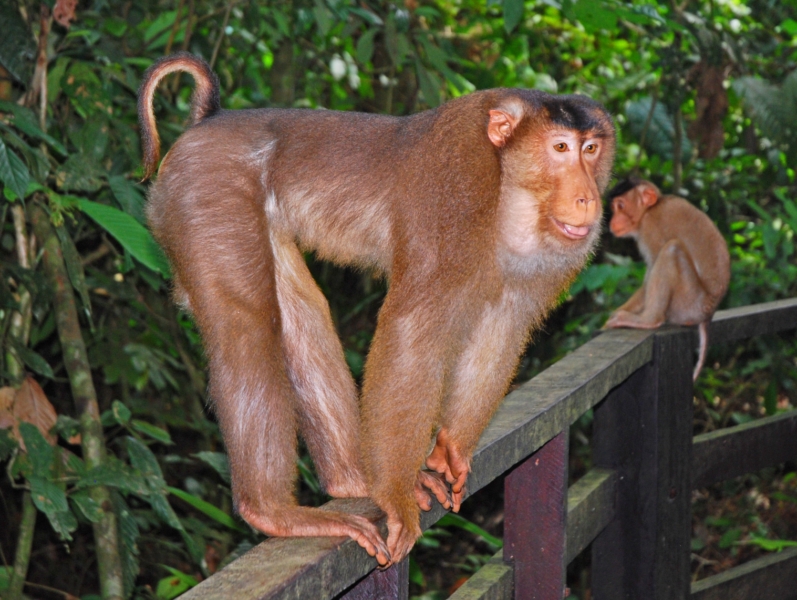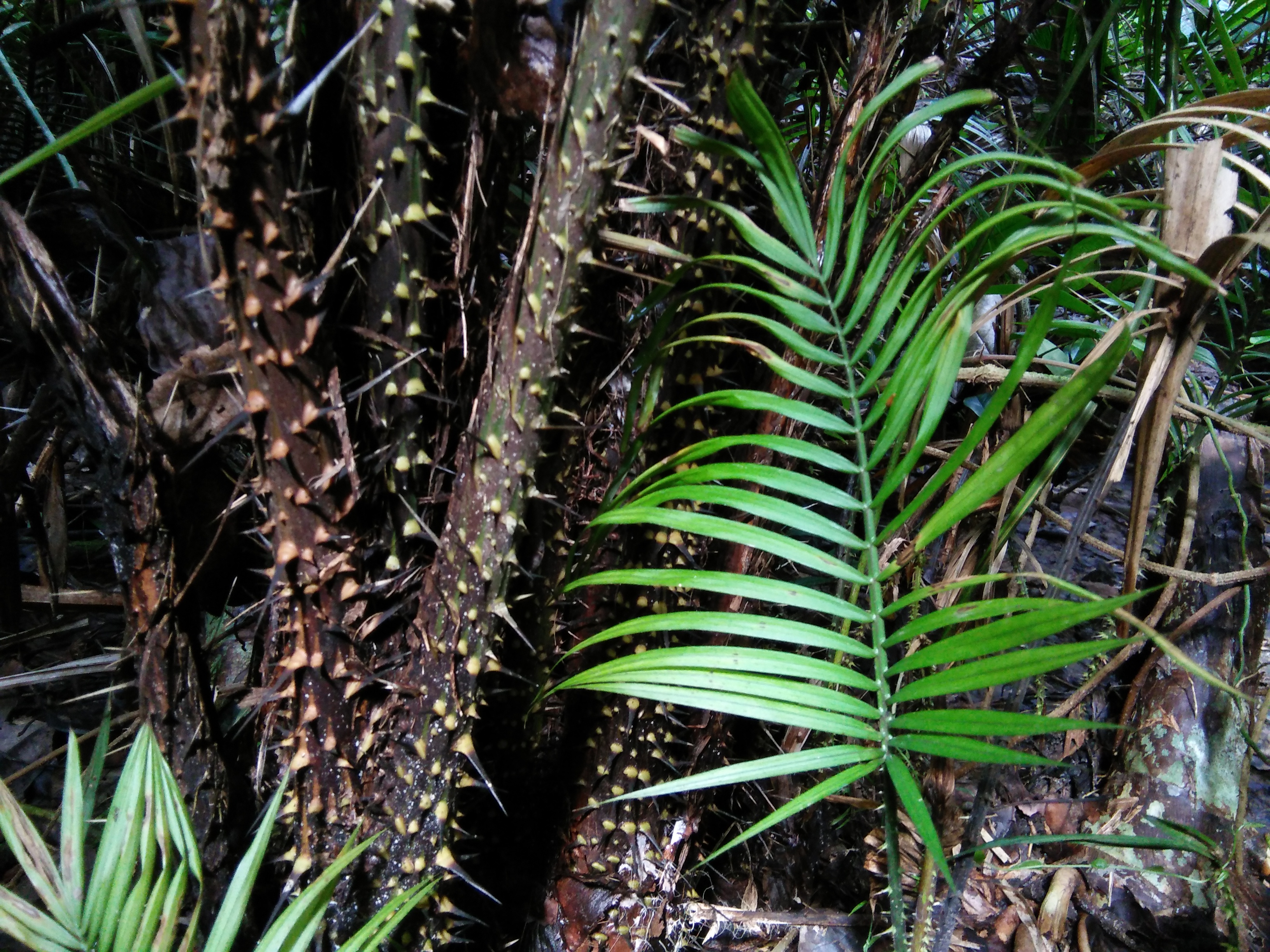|
Macaca Nemestrina
The southern pig-tailed macaque (''Macaca nemestrina''), also known as the Sundaland pig-tailed macaque and the Sunda pig-tailed macaque, is a medium-sized macaque that lives in Sundaland, southern Thailand, Malaysia, and Indonesia. It is known locally as beruk. Etymology and taxonomy The species epithet, ''nemestrina'', is an adjective (derived from Latin , meaning "the god of groves") modified to agree in gender with the feminine generic name. ''M. nemestrina'' formerly included the northern pig-tailed, Pagai Island, and Siberut macaques as subspecies. All four are now considered separate species. In the 19th century, ''bruh'' was the native name used by Malays in Sumatra for the macaque. Description As with other ''Macaca'' species, males are larger than females; while males are measured at in length and in weight, females are measured at in length and in weight. This macaque has buff-brown fur, with a darker dorsal area and lighter ventral area. Its common name ... [...More Info...] [...Related Items...] OR: [Wikipedia] [Google] [Baidu] |
Macaque
The macaques () constitute a genus (''Macaca'') of gregarious Old World monkeys of the subfamily Cercopithecinae. The 23 species of macaques inhabit ranges throughout Asia, North Africa, and Europe (in Gibraltar). Macaques are principally frugivorous (preferring fruit), although their diet also includes seeds, leaves, flowers, and tree bark. Some species such as the long-tailed macaque (''M. fascicularis''; also called the crab-eating macaque) will supplement their diets with small amounts of meat from shellfish, insects, and small mammals. On average, a southern pig-tailed macaque (''M. nemestrina'') in Malaysia eats about 70 large rats each year. All macaque social groups are arranged around dominant matriarchs. Macaques are found in a variety of habitats throughout the Asian continent and are highly adaptable. Certain species are synanthropic, having learned to live alongside humans, but they have become problematic in urban areas in Southeast Asia and are not suitabl ... [...More Info...] [...Related Items...] OR: [Wikipedia] [Google] [Baidu] |
Prague Zoo
Prague Zoological Garden (Czech: ''Zoologická zahrada hl. m. Prahy'') is a zoo in Prague, Czech Republic. It was opened in 1931 with the goal to "advance the study of zoology, protect wildlife, and educate the public" in the district of Troja (Prague), Troja in the north of Prague. In 2013, the zoo occupied with in use for exhibits, and housed around 5,000 animals from 676 species, including 132 species listed as Threatened species, threatened. The zoo is rated as the seventh best zoo in the world by Forbes Travel Guide in 2007, and is rated as the fifth best in the world by TripAdvisor. The zoo has contributed significantly to saving Przewalski's horse; for many years, it was the leading breeder of the subspecies. The zoo director is Miroslav Bobek. History The idea for a zoological garden in Prague was first proposed in 1881 in a newspaper article by Count Sweerts-Spork, on the occasion of the marriage of Crown Prince Rudolf of Austria and Princess Stéphanie of Belgium. In ... [...More Info...] [...Related Items...] OR: [Wikipedia] [Google] [Baidu] |
Arboreal Locomotion
Arboreal locomotion is the animal locomotion, locomotion of animals in trees. In habitats in which trees are present, animals have evolution, evolved to move in them. Some animals may scale trees only occasionally (scansorial), but others are exclusively arboreal. The habitats pose numerous mechanical challenges to animals moving through them and lead to a variety of anatomical, behavioral and ecological consequences as well as variations throughout different species.Matt Cartmill, Cartmill, M. (1985). "Climbing". pp. 73–88 ''In'': Hildebrand, Milton; Bramble, Dennis M.; species:Karel Frederik Liem, Liem, Karel F.; David B. Wake, Wake, David B. (editors) (1985). ''Functional Vertebrate Morphology''. Cambridge, Massachusetts: Harvard University Press, Belknap Press. 544 pp. . Furthermore, many of these same principles may be applied to climbing without trees, such as on rock piles or mountains. Some animals are exclusively arboreal in habitat, such as tree snails. Biomechanic ... [...More Info...] [...Related Items...] OR: [Wikipedia] [Google] [Baidu] |
Alpha (ethology)
In the zoological field of ethology, a dominance hierarchy (formerly and colloquially called a pecking order) is a type of social hierarchy that arises when members of animal social groups interact, creating a ranking system. Different types of interactions can result in dominance depending on the species, including ritualized displays of aggression or direct physical violence. In social living groups, members are likely to compete for access to limited resources and mating opportunities. Rather than fighting each time they meet, individuals of the same sex establish a relative rank, with higher-ranking individuals often gaining more access to resources and mates. Based on repetitive interactions, a social order is created that is subject to change each time a dominant animal is challenged by a subordinate one. Definitions Dominance is an individual's preferential access to resources over another based on coercive capacity based on strength, threat, and intimidation, com ... [...More Info...] [...Related Items...] OR: [Wikipedia] [Google] [Baidu] |
Heredity
Heredity, also called inheritance or biological inheritance, is the passing on of traits from parents to their offspring; either through asexual reproduction or sexual reproduction, the offspring cells or organisms acquire the genetic information of their parents. Through heredity, variations between individuals can accumulate and cause species to evolve by natural selection. The study of heredity in biology is genetics. Overview In humans, eye color is an example of an inherited characteristic: an individual might inherit the "brown-eye trait" from one of the parents. Inherited traits are controlled by genes and the complete set of genes within an organism's genome is called its genotype. The complete set of observable traits of the structure and behavior of an organism is called its phenotype. These traits arise from the interaction of the organism's genotype with the environment. As a result, many aspects of an organism's phenotype are not inherited. For example, ... [...More Info...] [...Related Items...] OR: [Wikipedia] [Google] [Baidu] |
Matrilineality
Matrilineality, at times called matriliny, is the tracing of kinship through the female line. It may also correlate with a social system in which people identify with their matriline, their mother's lineage, and which can involve the inheritance of property and titles. A matriline is a line of descent from a female ancestor to a descendant of either gender in which the individuals in all intervening generations are mothers. In a matrilineal descent system, individuals belong to the same descent group as their mothers. This is in contrast to the currently more popular pattern of patrilineal descent from which a family name is usually derived. The matriline of historical nobility was also called their enatic or uterine ancestry, corresponding to the patrilineal or "agnatic" ancestry. Early human kinship Scholars disagree on the nature of early human, that is, Homo sapiens, kinship. In the late 19th century, most scholars believed, influenced by Lewis H. Morgan's book ' ... [...More Info...] [...Related Items...] OR: [Wikipedia] [Google] [Baidu] |
Dominance Hierarchy
In the zoological field of ethology, a dominance hierarchy (formerly and colloquially called a pecking order) is a type of social hierarchy that arises when members of animal social animal, social groups interact, creating a ranking system. Different types of interactions can result in dominance depending on the species, including Ritualized aggression, ritualized displays of aggression or direct physical violence. In social living groups, members are likely to compete for access to limited resources and mating opportunities. Rather than fighting each time they meet, individuals of the same sex establish a relative rank, with higher-ranking individuals often gaining more access to resources and mates. Based on repetitive interactions, a social order is created that is subject to change each time a dominant animal is challenged by a subordinate one. Definitions Dominance is an individual's preferential access to resources over another based on coercive capacity based on streng ... [...More Info...] [...Related Items...] OR: [Wikipedia] [Google] [Baidu] |
Calamus Castaneus
Calamus may refer to: Botany and zoology * ''Calamus'' (fish), a genus of fish in the family Sparidae * ''Calamus'' (palm), a genus of rattan palms * Calamus, the hollow shaft of a feather, also known as the quill * ''Acorus calamus'', the sweet flag, a tall wetland plant, commonly referred to as calamus in herbal medicine Place names * Calamus, Iowa, United States * Calamus, Wisconsin, United States * Calamus Creek (other) * Calamus Swamp, Ohio, United States Other uses * Calamus (DTP), a desktop publishing application * Calamus (poems), a series of poems by American writer Walt Whitman * Calamus Ensemble, a classical music ensemble featuring Roberto Carnevale * Ensemble Cálamus, a classical music ensemble featuring Eduardo Paniagua * USS ''Calamus'' (AOG-5) a ''Mettawee''-class gasoline tanker acquired by the U.S. Navy * Calamus or Kalamos, a figure in Greek mythology *Calamus, a character from the 2014 puzzle/adventure game OneShot See also * Calamis (disa ... [...More Info...] [...Related Items...] OR: [Wikipedia] [Google] [Baidu] |
Rattan
Rattan, also spelled ratan (from Malay language, Malay: ''rotan''), is the name for roughly 600 species of Old World climbing palms belonging to subfamily Calamoideae. The greatest diversity of rattan palm species and genera are in the closed-Canopy (biology), canopy Old-growth forest, old-growth tropical forests of Southeast Asia, though they can also be found in other parts of tropical Asia and Africa. Most rattan palms are ecologically considered lianas due to their climbing habits, unlike other palm species. A few species also have tree-like or shrub-like habits. Around 20% of rattan palm species are economically important and are traditionally used in Southeast Asia in producing wickerwork furniture, baskets, Walking stick, canes, woven mats, Rope, cordage, and other handicrafts. Rattan canes are one of the world's most valuable non-timber forest products. Some species of rattan also have edible scaly fruit and heart of palm. Despite increasing attempts in the last 30 y ... [...More Info...] [...Related Items...] OR: [Wikipedia] [Google] [Baidu] |
Invertebrate
Invertebrates are animals that neither develop nor retain a vertebral column (commonly known as a ''spine'' or ''backbone''), which evolved from the notochord. It is a paraphyletic grouping including all animals excluding the chordata, chordate subphylum Vertebrata, i.e. vertebrates. Well-known Phylum, phyla of invertebrates include arthropods, molluscs, annelids, echinoderms, flatworms, cnidarians, and sponges. The majority of animal species are invertebrates; one estimate puts the figure at 97%. Many invertebrate taxon, taxa have a greater number and diversity of species than the entire subphylum of Vertebrata. Invertebrates vary widely in size, from 10 Micrometre, μm (0.0004 in) myxozoans to the 9–10 m (30–33 ft) colossal squid. Some so-called invertebrates, such as the Tunicata and Cephalochordata, are actually sister chordate subphyla to Vertebrata, being more closely related to vertebrates than to other invertebrates. This makes the "invertebrates" para ... [...More Info...] [...Related Items...] OR: [Wikipedia] [Google] [Baidu] |
Fungus
A fungus (: fungi , , , or ; or funguses) is any member of the group of eukaryotic organisms that includes microorganisms such as yeasts and mold (fungus), molds, as well as the more familiar mushrooms. These organisms are classified as one of the kingdom (biology)#Six kingdoms (1998), traditional eukaryotic kingdoms, along with Animalia, Plantae, and either Protista or Protozoa and Chromista. A characteristic that places fungi in a different kingdom from plants, bacteria, and some protists is chitin in their cell walls. Fungi, like animals, are heterotrophs; they acquire their food by absorbing dissolved molecules, typically by secreting digestive enzymes into their environment. Fungi do not photosynthesize. Growth is their means of motility, mobility, except for spores (a few of which are flagellated), which may travel through the air or water. Fungi are the principal decomposers in ecological systems. These and other differences place fungi in a single group of related o ... [...More Info...] [...Related Items...] OR: [Wikipedia] [Google] [Baidu] |








